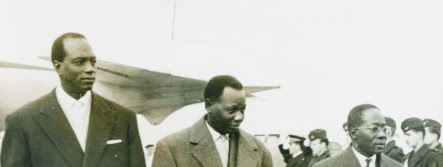By Cheikh Fall | The Third Path Africa

From Left to Right Modibo Keita, Mamadou Dia, and Leopold Sedar Senghor
In the late 1950s, as Africa shook off colonial chains, a bold vision emerged in French-speaking West Africa: the Mali Federation. Uniting Senegal and the Sudanese Republic (modern-day Mali), this short-lived union of 1960 embodied the continent’s dream of collective strength. Yet, within months, it fractured, leaving lessons that echo in today’s quest for African unity. What drove this ambition, what did it achieve, why did it fail, and could it be revived?
The Impulse for Unity
The Mali Federation arose from decolonization’s fervor. As French rule crumbled, leaders Léopold Sédar Senghor of Senegal and Modibo Keïta of French Sudan saw unity as a shield against the fragility of small states. Inspired by pan-African ideals, mirrored in the Ghana-Guinea Union, they aimed to pool resources, resist neo-colonial pressures, and amplify Africa’s voice, envisioning a broader West African bloc with Upper Volta and Dahomey.
Objectives of the Federation
The federation sought a unified state with shared governance and economic cooperation. Its goals included equal representation through a federal assembly, a single political party, and harmonized social movements. A key ambition was a railway linking Dakar’s port to Bamako’s hinterlands, vital for landlocked Mali’s trade. The parity principle ensured neither territory dominated, while ties with France’s Community balanced autonomy and partnership.
Achievements in a Brief Existence
From April 1959 to August 1960, the Mali Federation achieved remarkable steps. It secured independence from France on June 20, 1960, showcasing African agency. In Bamako, farmers like Moussa Traoré dreamed of thriving trade via Dakar’s ports, fueling grassroots support. A federal assembly with 20 representatives per territory, led by Keïta as premier and Senegal’s Mamadou Dia as vice-premier, adopted a constitution rooted in parity, inspiring later regional efforts.
Comparison of Senegal and Sudanese Republic (1960)
| Metric | Senegal | Sudanese Republic |
|---|---|---|
| Population | ~3.1 million | ~4.3 million |
| GDP (est., 1960 USD) | ~$300 million | ~$200 million |
| Infrastructure | Dakar port, railway hub | Limited roads, railway access |
| Note: Population and GDP are estimates based on historical data; infrastructure reflects railway access (World Bank/UN). | ||
Difficulties Encountered
Ideological rifts plagued the federation. Keïta’s socialist, centralized vision clashed with Senghor’s moderate approach, stalling decisions on military roles, French ties, and railway funding/control, which foreshadowed deeper divisions. The parity principle caused gridlock, and integrating distinct political systems proved contentious. External pressures, including France’s ambivalence and Ivory Coast’s opposition, weakened the union.
Why It Broke Down
The federation collapsed in August 1960 after a military standoff. On August 19, Sudanese leaders mobilized the army, prompting Senegal’s gendarmerie to respond, leading to Senegal’s withdrawal. The Sudanese Republic, renamed Mali, severed ties. Ambiguities in federal structures and external pressures from France and Ivory Coast fueled mistrust.
Who Bears Responsibility?
Keïta’s socialist push and Senghor’s pragmatic stance hindered compromise. France and regional rivals like Ivory Coast played roles, but the lack of time to build a shared political culture was critical.
Lessons Learned
The federation’s failure underscores the need for ideological alignment, clear institutions, and resistance to external interference. Trust and shared identity require time. Had the federation endured, it might have inspired a stronger West African bloc, potentially altering the trajectory of conflicts like the Sahel insurgencies.
Can It Be Done Again?
Reviving a union today faces hurdles but holds promise. West Africa’s crises—security, economic fragility—echo 1960s concerns. The African Continental Free Trade Area (AfCFTA), launched in 2021, mirrors the federation’s economic ambitions, like the railway (now vital for Mali’s trade), but benefits from broader buy-in and clearer frameworks. Mali’s isolationist junta contrasts with Senegal’s democratic path, suggesting smaller collaborations are more feasible than a full union.
Conclusion
The Mali Federation was a bold experiment, undone by ideological divides and external pressures. Its legacy—grassroots dreams, a vital railway, and hard-learned lessons—urges Africa toward pragmatic unity. As the continent navigates modern challenges, the federation’s story inspires cautious optimism for a stronger, united future.